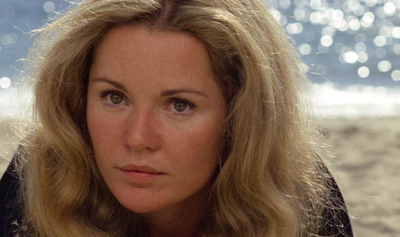For a film that so expertly captures the sun-blasted anomie of Southern California and its habit of desaturating whatever shades and emotions trespass into its path, it’s the bookending moments in labyrinthine, verdant gardens that shape the emotional space we find ourselves in. One of the greatest and most difficult-to-see films of the 1970s, Play It as It Lays is finally receiving its laurels in the form of a 4K restoration, with four upcoming screenings at the Belcourt. There is simply no offering more essential to be found in theaters.
There’s a melancholy to this film that feels undiluted by the intervening five-plus decades. Part of that is because of its unavailability outside of repertory theaters (and one open-matte Sundance Channel broadcast that flitted around the internet for years like a tulpa, kept in existence thanks to cinephiles, Joan Didion readers and those tuned into Anthony Perkins’ legacy or some of that distinctive Tuesday Weld-schmerz). But that’s not to say Play It as It Lays was exceptionally desolate and matter-of-fact in comparison to the other films of the ’70s, which were exploring domestic angst and the alienation of success without love — it’s just that unfamiliarity has kept the film out of reach.
The film’s wrenching death by a hundred-thousand sharp slices from each grain of sand propelled by the Santa Ana winds hasn’t been allowed to symbolize anything in mass culture, and as such it feels like nothing else. It is somehow both the opposite of and a perfect companion piece to 1968’s Pretty Poison — the first pairing of Tuesday Weld and Anthony Perkins, five years prior, which is also essential viewing.
There isn’t anyone quite like Weld. An object lesson in how to control one’s image, career and legacy, she was a massive star who simply stepped away. She did things her way, letting what was available of the work (as well as the 1991 Matthew Sweet album she graced the cover of) speak for itself. Her hair in this film is sculpture, a tear in space wrought by wind and sheer will, and her character Maria (pronounced with that second vowel lengthened) is somehow fighting for resonance and relevance as her marriage and career teeter above oblivion. Weld is simply superb. Truthfully, she always is.
If the conventional shorthand of what Weld was doing in the ’70s and early ’80s focused on her willingness to explore the role that abortion played in women’s lives during that transitional time in history, so be it. It’s an exceptional body of work, one that lingers when we talk about how cinema was absorbing and processing the social movements of that era. But that’s in no way meant to shortchange what Perkins is doing here.
Long an incarnation of complicated sexuality and the baroque behind-the-scenes lives lurking behind Hollywood gossip columns, his performance as the nominally closeted producer BZ is offering something that aches for a different era. There are emotional notes here that break your heart, wicked humor, even for the ’70s, and an ongoing sense of pervasive sadness that makes you wish BZ and Maria could have together found a new path — a different one where they could have both found some kind of happiness on their own terms.
As for director Frank Perry, there are some who still like to beat his corpse with the club that is 1982’s Mommie Dearest. These are the same people who haven’t forgiven Robert Altman for songwriting choices when he made Nashville, the bleating of those put upon by having been challenged. Perry’s work, both with his ex-wife Eleanor and his later material, accesses emotions that don’t normally lend themselves to the realm of the visual, and anyone whose career encompasses David and Lisa, Last Summer, Doc, Rancho Deluxe and The Swimmer is not someone who needs to have their reputation defended by me.
Screenwriter Joan Didion would often disparage the adaptation she and her husband John Gregory Dunne made of her own novel, and I am in no position to speak to this. The film holds such power (at least in the electrified goo of my own brain) that it precludes me from reading the book, echoing its need for empathic connection across the years. It’s the call of the void, whatever it is the voices on desert winds may say. A road trip with a scenic route of the abject, and an easy (at first) melancholy, and the roads all converge on that blinding horizon, just out of sight.





